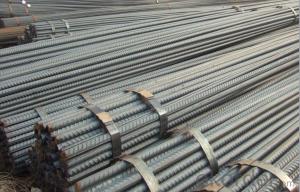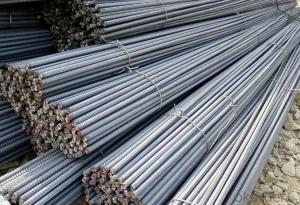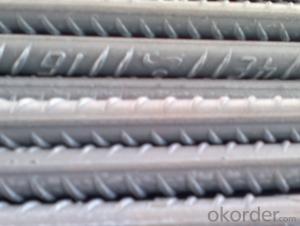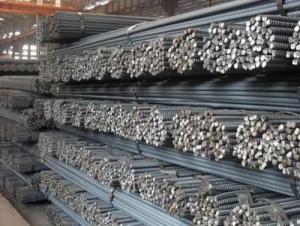Hot Rolled Carbon Steel Rebar 12mm with High Quality
- Loading Port:
- China Main Port
- Payment Terms:
- TT or LC
- Min Order Qty:
- 25 m.t.
- Supply Capability:
- 10000 m.t./month
OKorder Service Pledge
OKorder Financial Service
You Might Also Like
Product Description:
OKorder is offering Hot Rolled Carbon Steel Rebar 12mm with High Quality at great prices with worldwide shipping. Our supplier is a world-class manufacturer of steel, with our products utilized the world over. OKorder annually supplies products to European, North American and Asian markets. We provide quotations within 24 hours of receiving an inquiry and guarantee competitive prices.
Product Applications:
Hot Rolled Carbon Steel Rebar 12mm with High Quality is widely used in buildings, bridges, roads and other engineering construction. Big to highways, railways, bridges, culverts, tunnels, public facilities such as flood control, dam, small to housing construction, beam, column, wall and the foundation of the plate, deformed bar is an integral structure material. With the development of world economy and the vigorous development of infrastructure construction, real estate, the demand for deformed bar will be larger and larger..
Product Advantages:
OKorder's Hot Rolled Carbon Steel Rebar 12mm with High Quality are durable, strong.packed and suitable for construction
Main Product Features:
· Premium quality
· Prompt delivery & seaworthy packing (30 days after receiving deposit)
· Can be recycled and reused
· Mill test certification
· Professional Service
· Competitive pricing
Product Specifications:
Manufacture: Hot rolled
Grade: HRB335 HRB400 BS4449 Grade460 ASTM Grade40 Grade60
Certificates: ISO, SGS, BV, CIQ
Length:6m 8m 9m 12m
Packaging: Export packing, packed by coil
FAQ:
Q1: Why buy Materials & Equipment from OKorder.com?
A1: All products offered byOKorder.com are carefully selected from China's most reliable manufacturing enterprises. Through its ISO certifications, OKorder.com adheres to the highest standards and a commitment to supply chain safety and customer satisfaction.
Q2: How do we guarantee the quality of our products?
A2: We have established an advanced quality management system which conducts strict quality tests at every step, from raw materials to the final product. At the same time, we provide extensive follow-up service assurances as required.
Q3: How soon can we receive the product after purchase?
A3: Within three days of placing an order, we will begin production. The specific shipping date is dependent upon international and government factors, but is typically 7 to 10 workdays.
Q4: Can you supply the Rebar according to the standard KS?
A4: Yes, we can supply SD400 and SD500
Q5: How to avoid the rust after deliver the goods to the loading port?
A5: We will keep the goods at the port covered with water-proof material
Q6: What is the chemical composition and physical properties of HRB400?
A6:
Grade | Technical data of the original chemical composition (%) | ||||||
C | Mn | Si | S | P | V | ||
HRB400 | ≤0.25 | ≤1.60 | ≤0.80 | ≤0.045 | ≤0.045 | 0.04-0.12 | |
Physical capability | |||||||
Yield Strength (N/cm²) | Tensile Strength (N/cm²) | Elongation (%) | |||||
≥400 | ≥570 | ≥14 | |||||
Images:
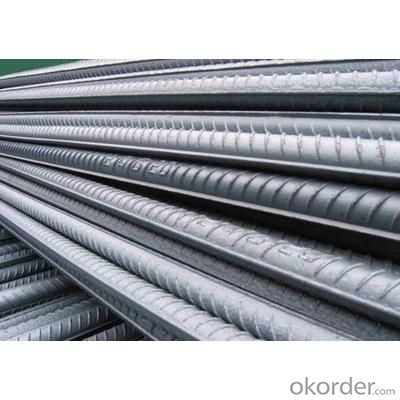
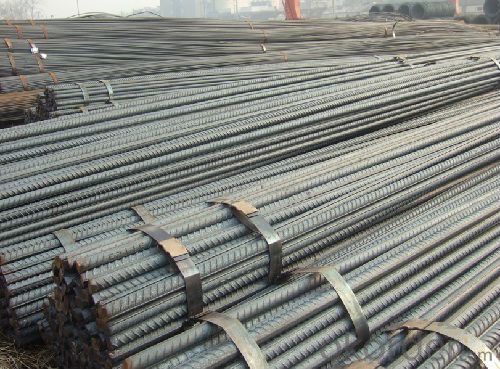
- Q:What is the impact of steel rebars on the overall carbon footprint of a construction project?
- Steel rebars have a significant impact on the overall carbon footprint of a construction project. As a key component in reinforced concrete structures, the production of steel rebars involves high energy consumption and emissions of greenhouse gases, contributing to the project's carbon footprint. However, steel rebars offer durability and strength, reducing the need for frequent repairs or replacements, which can offset their initial carbon emissions over the lifespan of the structure. Additionally, using recycled steel rebars can further minimize the carbon footprint by reducing the energy and emissions associated with the production of new steel.
- Q:How do steel rebars affect the structural capacity of concrete beams and columns?
- Steel rebars play a crucial role in enhancing the structural capacity of concrete beams and columns. They act as reinforcement, providing additional strength and durability to the concrete elements. By adding steel rebars into the concrete, the overall load-bearing capacity of the beams and columns increases significantly. One of the primary functions of steel rebars is to counteract the tensile forces that concrete cannot withstand on its own. Concrete is strong in compression but weak in tension, making it susceptible to cracking and failure under tensile stress. By incorporating steel rebars into the concrete, the tensile strength of the reinforced element is greatly improved. The steel rebars act as a skeleton within the concrete, distributing the load more evenly and reducing the risk of localized failure. When subjected to external loads or forces, the rebars bear the tensile stress while the concrete maintains its compressive strength. This combination of materials creates a reinforced concrete element that can withstand higher loads, increasing the structural capacity of the beams and columns. Additionally, steel rebars also enhance the ductility and flexibility of the concrete elements. This means that the reinforced beams and columns can undergo greater deformations before failing. The ability to deform without breaking is crucial in earthquake-prone areas, as it allows the structure to absorb and dissipate energy, thereby reducing the risk of collapse. Furthermore, steel rebars improve the resistance of concrete beams and columns against shrinkage and thermal stresses. Concrete tends to shrink as it cures and expand and contract under temperature variations. The presence of steel rebars helps to minimize these effects by providing a reinforcing network that restrains the concrete from excessive movements, preventing cracks and maintaining the overall structural integrity. In summary, steel rebars greatly impact the structural capacity of concrete beams and columns by increasing their tensile strength, improving ductility, reducing shrinkage and thermal stresses, and enhancing overall load-bearing capacity. The combination of concrete and steel reinforcement results in a much stronger and more durable structural element, capable of withstanding higher loads and ensuring the stability and safety of the overall structure.
- Q:What is the effect of welding defects on the performance of steel rebars?
- Welding defects can have a significant impact on the performance of steel rebars. These defects can weaken the structural integrity of the rebars, leading to potential failures and compromising the overall strength and durability of the construction project. One of the common welding defects is porosity, which is caused by the presence of gas pockets or voids in the weld. Porosity weakens the weld joint, reducing its load-bearing capacity and making it more susceptible to cracking or breaking under stress. This can result in a decreased resistance to external forces, such as the weight of the structure or seismic activities, leading to potential collapse or structural failure. Another welding defect is lack of fusion, which occurs when there is insufficient bonding between the base metal and the weld metal. This results in a weak joint that is prone to separation or cracking under load. Lack of fusion can lead to reduced mechanical strength and compromised structural performance, as the rebars may not be able to withstand the expected load or forces exerted on them. Furthermore, the presence of weld spatter or excessive weld reinforcement can also negatively affect the performance of steel rebars. Weld spatter refers to the undesirable splashes or droplets of molten metal that can adhere to the surface of the rebar, creating potential weak points. Excessive weld reinforcement, on the other hand, can add unnecessary weight to the rebar and create stress concentrations, further increasing the likelihood of failure. In summary, welding defects on steel rebars can significantly impact their performance by weakening the structural integrity, reducing load-bearing capacity, and increasing the susceptibility to cracking or breaking under stress. Therefore, it is crucial to ensure proper welding techniques and quality control measures are in place to minimize or eliminate these defects and ensure the safety and reliability of the construction project.
- Q:Is cold-rolled ribbed steel bar thread steel?
- I haven't heard of cold-rolled steel. Cold rolling is called thin plate
- Q:What is the effect of impurities on the corrosion resistance of steel rebars?
- Impurities in steel rebars can have a negative impact on their corrosion resistance. These impurities, such as sulfur, phosphorus, and certain non-metallic inclusions, can promote the formation of localized corrosion sites and accelerate the corrosion process. Additionally, impurities can weaken the protective oxide layer on the surface of the steel, making it more susceptible to corrosion. Therefore, minimizing impurities in steel rebars is crucial to ensure their long-term corrosion resistance and structural integrity.
- Q:What are the factors that affect the strength of steel rebars?
- The factors that affect the strength of steel rebars include the composition of the steel, the manufacturing process, the presence of impurities, the size and shape of the rebar, and the conditions in which it is used, such as temperature and exposure to corrosion.
- Q:Can steel rebars be used in structures with high resistance to fatigue?
- Yes, steel rebars can be used in structures with high resistance to fatigue. Steel rebars are commonly used as reinforcement in concrete structures due to their high tensile strength and durability. They are designed to provide additional strength and support to the concrete, making the structure more resistant to various loads and stresses, including fatigue. Fatigue is the weakening of a material caused by repeated stress cycles, which can lead to structural failure over time. Steel rebars, especially those made from high-strength steel, are specifically manufactured to withstand cyclic loading and provide excellent resistance to fatigue. They have a high fatigue strength, allowing them to endure repeated stress cycles without significant deterioration. In structures with high resistance to fatigue, steel rebars are strategically placed to distribute and dissipate the applied loads, reducing stress concentrations and minimizing the risk of fatigue failure. The reinforcement provided by steel rebars enhances the overall structural integrity and longevity of the construction. Moreover, the use of steel rebars allows for the implementation of various design techniques, such as the inclusion of additional reinforcing elements like stirrups and tie hooks, which further enhance the fatigue resistance of the structure. These design considerations help ensure that the steel rebars effectively mitigate the effects of cyclic loading and maintain the structural stability and performance over time. However, it is essential to note that the fatigue resistance of a structure is not solely dependent on the steel rebars. Other factors, such as the quality of concrete, proper detailing and placement of rebars, and adherence to proper construction practices, also influence the overall fatigue performance of the structure. Therefore, it is crucial to consider a comprehensive approach that incorporates appropriate design, material selection, and construction techniques to achieve structures with high resistance to fatigue.
- Q:How do steel rebars contribute to the overall sustainability of concrete structures?
- Concrete structures benefit from the presence of steel rebars in various ways, thereby contributing to their overall sustainability. To start with, the durability and lifespan of concrete structures are significantly enhanced by steel rebars. By reinforcing the concrete, rebars provide additional strength and prevent cracks or structural failures, thereby extending the structure's life. This reduces the need for frequent repairs or replacements, conserving resources and minimizing the environmental impact of construction activities. Furthermore, steel rebars are entirely recyclable. When a structure reaches the end of its life cycle, the rebars can be easily extracted and recycled, reducing the demand for new raw materials and minimizing waste. This not only conserves natural resources but also reduces greenhouse gas emissions associated with the extraction and production of fresh steel. Incorporating steel rebars into concrete structures also allows for the use of thinner concrete sections. By using less concrete, the demand for cement, a significant source of carbon dioxide emissions during production, is reduced. Therefore, the use of steel rebars helps to lower the overall carbon footprint of concrete structures. Moreover, steel rebars can be designed to resist corrosion, which is a common problem in concrete structures exposed to harsh environments or coastal areas. By providing protection against corrosion, the rebars increase the service life of the structure, reducing the need for maintenance and repairs. This not only saves costs but also reduces the environmental impact associated with maintenance activities. In conclusion, steel rebars play a vital role in enhancing the sustainability of concrete structures by improving their durability, enabling recycling, reducing material consumption, and minimizing maintenance requirements. By incorporating steel rebars into concrete construction, we can create long-lasting, environmentally-friendly structures that contribute to a more sustainable built environment.
- Q:What are the common myths and misconceptions about steel rebars?
- There are several common myths and misconceptions about steel rebars. One misconception is that all rebars are the same, when in fact there are different grades and types of rebars with varying properties and strengths. Another myth is that steel rebars are prone to rusting easily, but in reality, rebars are typically coated with protective substances or used in conjunction with concrete to prevent corrosion. Additionally, some people believe that steel rebars are not environmentally friendly, but they are actually highly recyclable and can be reused in various construction projects. Overall, it's important to dispel these myths and understand the true characteristics and benefits of steel rebars in construction.
- Q:How do steel rebars contribute to sustainable construction practices?
- There are several ways in which steel rebars contribute to sustainable construction practices: 1. Enhanced durability: Steel rebars possess a high level of durability and have a long lifespan, which results in less frequent replacements or repairs. This helps in minimizing the generation of waste and conserving valuable resources. 2. Advancement in structural strength: Steel rebars offer superior strength and structural integrity to reinforced concrete. This enables the construction of tall buildings and structures, reducing the need for land consumption and encouraging vertical growth in urban areas. 3. Energy-conscious production: Steel rebars are manufactured using energy-efficient processes, reducing the carbon footprint associated with their production. Moreover, their use in reinforced concrete structures improves energy efficiency by reducing the requirement for additional insulation materials. 4. Recyclability: Steel rebars are entirely recyclable, meaning they can be melted down and reused in new construction projects. This diminishes the demand for new steel, conserving natural resources and reducing greenhouse gas emissions related to steel production. 5. Waste reduction: The application of steel rebars in reinforced concrete structures reduces the quantity of construction and demolition waste generated. By providing a strong and long-lasting structure, it minimizes the necessity for frequent renovations or replacements, ultimately reducing waste generation over time. 6. Strengthened seismic resistance: Steel rebars enhance the ability of buildings and structures to withstand earthquakes and other natural disasters, thus improving their seismic resistance. This ensures the safety of occupants and reduces the post-disaster reconstruction efforts, contributing to sustainable development. Overall, the use of steel rebars in construction promotes sustainability by reducing waste, conserving resources, improving energy efficiency, and enhancing the durability and resilience of structures.
1. Manufacturer Overview |
|
|---|---|
| Location | |
| Year Established | |
| Annual Output Value | |
| Main Markets | |
| Company Certifications | |
2. Manufacturer Certificates |
|
|---|---|
| a) Certification Name | |
| Range | |
| Reference | |
| Validity Period | |
3. Manufacturer Capability |
|
|---|---|
| a)Trade Capacity | |
| Nearest Port | |
| Export Percentage | |
| No.of Employees in Trade Department | |
| Language Spoken: | |
| b)Factory Information | |
| Factory Size: | |
| No. of Production Lines | |
| Contract Manufacturing | |
| Product Price Range | |
Send your message to us
Hot Rolled Carbon Steel Rebar 12mm with High Quality
- Loading Port:
- China Main Port
- Payment Terms:
- TT or LC
- Min Order Qty:
- 25 m.t.
- Supply Capability:
- 10000 m.t./month
OKorder Service Pledge
OKorder Financial Service
Similar products
New products
Hot products
Hot Searches
Related keywords
